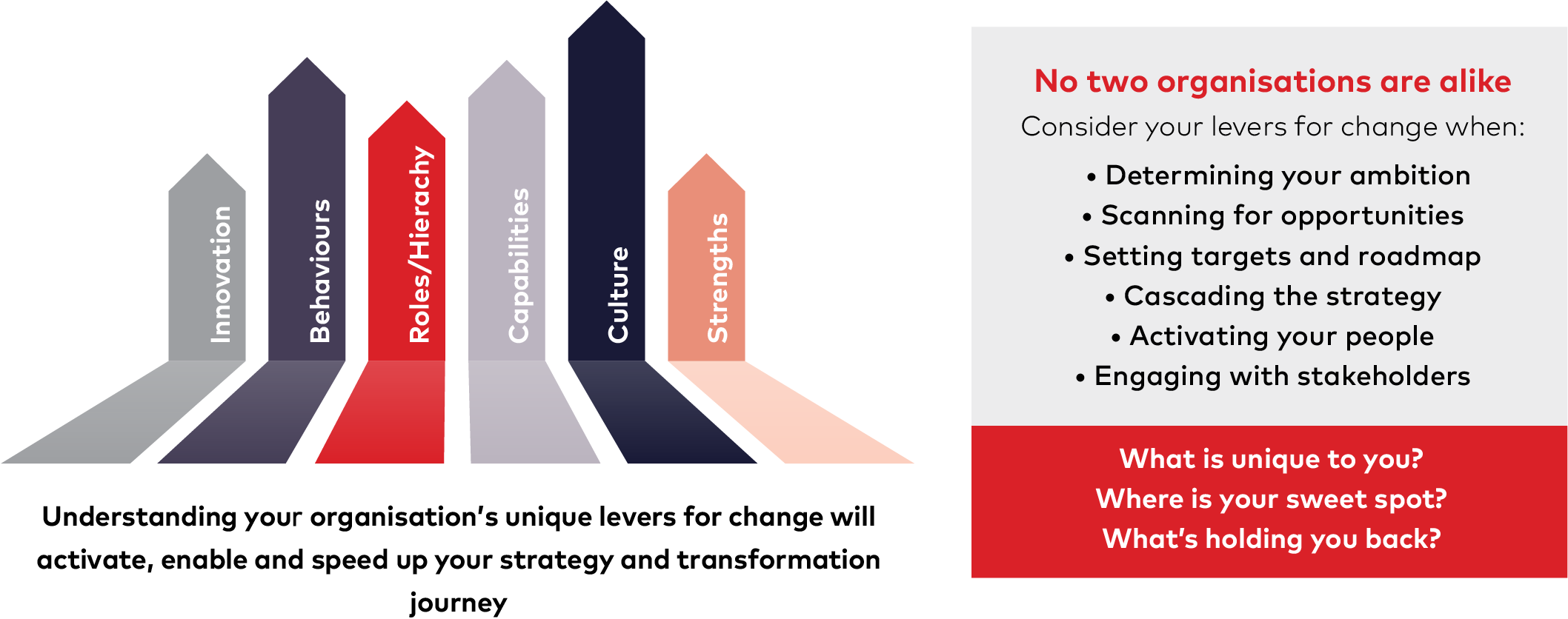From intent to impact: enabling the sustainability transformation through capabilities and culture
The world is changing, and for businesses to stay relevant, compliant, and competitive, they must change too.
Now is the time for leaders to build on the momentum and growing urgency to make business performance converge with positive impact – for people and the planet. What’s more, investors, customers, and employees all have a growing appetite for sustainability. This may be borne from different pressures, but ultimately demands the same thing: a clean, resilient, and sustainable business offer. Sustainability and environment, social, and governance (ESG) investing offer a clear business opportunity, driving innovation and competitiveness while fostering resilience. However, the complexity of implementing such change is difficult as it requires a holistic organisational and cultural transformation.

That means evaluating what sustainability means for your organisation, your products and services, and integrating it accordingly across business processes so it can drive you to greater competitiveness, resilience to crises, and brand loyalty. But as a company, once you decide to embark on such a sustainability transformation, it can be daunting to figure out where to start, how to transform the organisation, and how to do it at-scale.
Doing it right and delivering both impact and value takes commitment and dedication. Sustainability is a complex topic, and there is no single, correct, one-size-fits-all way to integrate it into your business operations. You will face numerous operational and mindset challenges as you orchestrate the journey to transform your organisation.
In our experience, having a strategy is only the start. Then when it comes to implementation, there are 3 key enablers:
- Applying each company’s unique levers for change, building on your company’s particular culture, market, and product offering.
- Building and sustaining momentum by empowering people at the heart of the transformation, which extends to creating enabling behaviours, mindsets, and culture.
- Embedding sustainability fully into the core of your business.

1. Finding what works to power your organisation’s sustainability journey
Every entity embarking on a sustainability journey needs to understand its unique levers for change, to not only spark the transformation, but also to support it in a way that honours, builds on, and reinforces the organisational culture.
L’Oreal, for example, is a company that puts science, data, and innovation at the heart of what it does. Those are its unique levers for change, allowing it to make significant industry contributions on product naturality, biodegradability, and carbon footprint.
In contrast, at the other end of the cosmetic company spectrum is The Body Shop, a brand focused on storytelling, and harnessing its irreverent and activist spirit to drive change internally and across the industry. Each company can use its company’s unique levers for change to inform the best angle and framework for their sustainability transformation.
A thorough understanding of stakeholder expectations and priorities – from investors to customers, employees, and other key partners – will inform the direction and strategy for change and also help identify the best levers. Setting this strategy and assessing the levers for change should be a deliberate exercise, an opportunity for engagement and transparency that is ideally powered by not just a desire for long-term change but to marry stakeholder priorities with a company’s unique potential for impact. Importantly, this process is key to empowering the company’s leadership and constituents for sustainable growth.
Such a process may lead to unexpected insights and opportunities. The Home Depot’s culture, for instance, is marked by an entrepreneurial high-spiritedness and a willingness to take risks so strong that it has been labelled as ‘‘orange blood’’ running through employees’ veins (orange being the colour of the company’s logo and core to its brand identity). When the need to meet more stringent regulatory or company-set environmental or social standards is challenged by additional costs, the culture of openness and innovativeness helps employees work together to identify areas where other costs could be reduced, or revenues could be increased by new approaches to sustainability. This co-creative effort rests on employees having a firm understanding of the company’s unique value-add, as well as a deep commitment to its sustainability ambitions, whilst being empowered to both innovate and apply an agile mindset to find new solutions.
In contrast, Kerry has a vision for a new food future, creating a world of sustainable nutrition. “Sustainability is a key part of our heritage and purpose at Kerry. It is also important to our people, who can see their own values reflected through the company’s activities”, says Juan Aguiriano, Head of Sustainability. They built on the company’s history and culture to set their purpose, focusing on ongoing and inclusive stakeholder engagement. Sustainable nutrition is not a new but a continuous journey. Kerry is working on what role they can play to help their customers advance in the nutritional space without compromising anything on the sustainability agenda.
With unique levers for change identified, the challenge becomes how to initiate and sustain your journey and ensure sustainability becomes a key part of the fabric of everything your organisation does.
2. Activating and sustaining your transformation journey
The journey is a complex one for any company, especially as transformation must apply across every aspect of the business and value chain, from suppliers to customers and even government relations.
When talking about a company’s particular ambition for positive impact and how to sustain such a transformation, some may dive into the question of how best to adapt roles and responsibilities, integrating sustainability into business processes, metrics, targets, and how to innovate on the front of product design and commercial strategies. The essential and often overlooked foundation of such a transformation, however, is the realisation that such a deep-seated change will require a culture and behavior change. That means working with your employees to get them excited for this shift – and committed to it. Not just as a one-off, but as part of a slow and long evolution that will see them internalise sustainability so it can then be reflected in every decision they make, and every aspect of their role.
The critical factor is to successfully adapt your business culture to sustain your transformation towards sustainability, thereby changing the underlying mindsets. For that, individuals and teams need to be empowered, motivated to be a part of the transformation, and enabled to think differently.
In ‘Making Sustainability Work’, authors Marc J. Epstein and Adriana Rejc Buhovac explain that success requires both the formal and informal systems to support the change – but that the “soft” systems are more important than most realise.1 That’s why your people, and organisational culture, are so intrinsic to success. For example, companies normally driven by performance targets leverage them fairly successfully as levers for change, usually strengthening those formal systems with informal engagement activities.
As such, there must be a process whereby as an organisation, you think about what this transformation means for you, for your people. This includes your workforce, who need to understand what it all means for their day-to-day activities, but also what it means for broader business partners.
You need to create an environment that drives change and embraces continuous improvement – and ensure that your culture integrates these elements too.

This requires a culture shift, a holistic and coordinated activation. Your company’s leadership and its employees, your people, need to approach problem-solving and everyday business with a new lens. Incentives will need to evolve accordingly. By recognising the organisation’s competencies and resources, you can activate the passion that will be the engine for your company’s transformation and sustained change. The idea is not only to spot opportunities to reduce negative impact, but most importantly to see how to generate value out of what was previously labeled “waste”, innovating with new products and different business models to fuel responsible growth. As George Serafeim states in his book ‘Purpose + Profit: How Business Can Lift Up The World’, “You need pressures from both ends – top-down and bottom-up; two forces pushing on the organisation to make things work and make them stick.”2
We know that learning and capacity building, both of which will have to be part of your sustainability transformation, are best integrated and “sticky” when they take place over time, are highly relevant, applied to real work, and are reinforced and supported by managers. What’s more, when employees are presented with personalised, custom-developed content where their environment, terminology and procedures are embedded in the learning, they tend to be more motivated and engaged.
In other words, it’s key not to underestimate the challenge and importance of activating and engaging your people. This will require multiple solutions, starting with training and capabilities building to catalyse new mindsets and the accompanying skillset. Activation will also need continuous interactions throughout the company to keep people energised, engaged, motivated, and empowered. Serafeim’s research shows the importance of the middle management layer, as that is where strategy and vision meet execution. If a consumer goods company talks about providing healthier products, but then doesn’t put the right financial incentives in place to get the middle managers to develop and market these products, the effort will fail.
At a large technology company, a three-pronged strategy combined the company’s leadership acting as sustainability ambassadors by cascading the message and guiding their teams through the transformation; a clear story and narrative adapted to the company’s culture; and reinforcing mechanisms including communications and training to better engage and evolve, as well as an adapted incentives’ structure. As a process-driven company, the most important consideration for their sustainability transformation was the integration of sustainability across all company processes.
Arcmont, a leading European private debt asset management firm, placed an emphasis on how to get company buy-in and establish oversight. To achieve this, they implemented a training program, appointed dedicated internal resources and established an ESG Committee that is comprised of senior individuals who sit with other functional decision-making committees. They also reinforced this structure by partnering with a leading external ESG advisory group who is fully integrated in their investment process.
All of this applies irrespective of what industry or market you operate in, and whether your motivation for change stems from regulatory compliance requirements, investor pressure, a desire to tap into ESG investing, or response to consumer pressure, among a myriad of others. However, the right way to implement the approach will depend on many variables, the combination of which make every company a unique challenge - from Kerry aiming to fundamentally transform its product portfolio to Arcmont improving its product competitiveness through ESG-integration.
Given the complexity of undertaking the successful implementation of a sustainability transformation, what are some of the mistakes to avoid? To answer that question, we can look to digital transformation initiatives.
3. Why integration into core business is essential, and change is a constant
An organisation undergoing a sustainability transformation will change from the inside out, like a tapestry that may still depict the same shepherding scene, but with a different quality thread running through it. New organisational capabilities – from roles to governance, processes, and even systems – will be in place, development will be on-going, and a cultural shift will occur. Nothing less will enable your company to embed sustainability in every single existing business function and to process and sustain a transformation and competitive market position.
One other topic has been at the source of transformations of a similar magnitude, and also requires embedding a new way of working into the operations and DNA of a company: digitalisation. Examples abound of both successful efforts and their counterparts – and we can learn from that in terms of what to do and what to avoid for a successful sustainability transformation.
For example, to truly “go digital”, it isn’t enough to overlay new technologies onto existing processes and people. There must be a fundamental shift in how people think and how things get done – and only then will the efforts live up to their full potential for positive impact. The same is true in the case of sustainability. If there’s no practical plan, no capacity to implement the digital transformation, or if the integration isn’t done in a way that is personalised to each user’s needs and ways of working, it’s only human for the change to fall short of its potential.
Organisations learn, evolve, and change. It’s part of how they stay relevant and competitive. A new leader may shift directions and announce a new business model, or start smaller and change a decision-making process. And these might be the right choices. The challenge, when it comes to your sustainability transformation, is that the approach is bespoke and cannot be piecemeal. Success requires commitment, a real integration of sustainability into your core business, and embracing change as a constant.
That’s why you cannot just take a top-down approach, or engage with your leadership, or rely on sustainability champions. For real change to happen, and to be sustainable over time, it needs to be an “all-hands-on-deck” approach as applicable to your company. As Serafeim says, “A strategic goal, accountability from the top down, and a top-to-bottom culture built around purpose are not always enough to actually get things done. The other piece of the puzzle is operational. The structure of a sustainable company needs to have sustainability infused into everything it does.”
In other words, what you want to do is to enable long-term change within your organisation, across your value chain, and perhaps even at a systemic level.
At Ecom, one of the world’s top merchants in coffee, cotton, and cocoa, the sustainability journey has led to the sustainability team being a part of every key decision-making process. While this will likely evolve over time, it ensures that sustainability is properly reflected in everything they do, and how they do it.

What does this mean for you?
The bottom line is that you should not underestimate the complexity of a sustainability transformation. However, if you understand the potential for a comprehensive integration of sustainability across the business, powered by the engagement of your people and a cultural transformation, you likely also understand that in this case, success is not a specific destination, but an on-going state of operations and constant evolution.
Once you identify your unique levers to enable the broader organisational change that is needed, use them to ignite and support the transformation. They can be combined with a design-thinking approach to identify the best ways to integrate sustainability across your business, and supported by champions at every level of your organisation who will facilitate the change required.
This is a marathon, not a sprint. Once you commit, embrace an agile approach whereby you adapt as needed, or “fail forward fast” as some may say. Run pilots to learn what truly works so you can scale it and thereby orchestrate the effort it will take for a successful transformation.
It will require coordination and frequent encouragement to manage the process of change while sustaining the momentum and engagement for transformation. However, if you’ve ever seen the difference between a caterpillar and a butterfly, you know it’s worth sprouting wings so you – and your company – can fly.
"This is a marathon, not a sprint. Once you commit, embrace an agile approach whereby you adapt as needed, or “fail forward fast” as some may say."
RESOURCES:
- Marc J. Epstein, Adriana Rejc Buhovac, 2014. Making Sustainability Work: Best Practices in Managing and Measuring Corporate Social, Environmental, and Economic Impacts, Berrett-Koehler Publisher
- George Serafeim, 2022. Purpose + Profit, Harper Collins.
Contact Us



